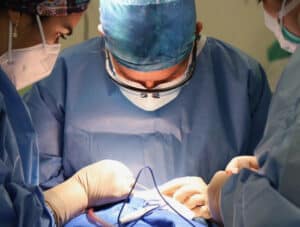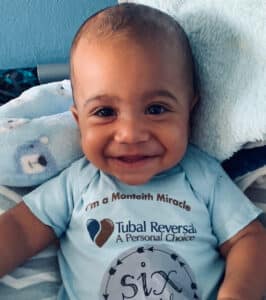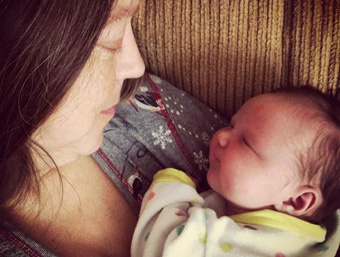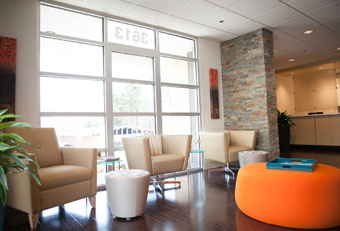If you are a doctor looking for tubal ligation reversal training (training in tubotubal anastomosis) then Dr Monteith may be able to help you.
 Dr. Charles Monteith is the Medical Director of A Personal Choice. He specializes in tubal reversal surgery. Dr. Monteith has been providing reversal surgery since 2008 and he is now offering tubal ligation reversal training to a few, select, motivated physicians.
Dr. Charles Monteith is the Medical Director of A Personal Choice. He specializes in tubal reversal surgery. Dr. Monteith has been providing reversal surgery since 2008 and he is now offering tubal ligation reversal training to a few, select, motivated physicians.
A Personal Choice is located in Raleigh, North Carolina. The center is exclusively dedicated to tubal ligation reversal and vasectomy reversal. Patients travel from across the United States to have tubal reversal surgery with Dr. Monteith.
Training in tubal ligation reversal is hard, if not impossible, to obtain during or after residency because most training programs do not provide exposure to reversal surgery.
Most academic centers are unable to offer training in reversal surgery because the cost of providing reversal surgery is prohibitive in large academic systems.
If you would like tubal ligation reversal training and add reversal surgery to your skill set then you should continue reading to understand more.
If you would like tubal ligation reversal training then complete this form at the bottom of this article and Dr Monteith will get back to you. We ask that you do not call our office to inquire about training. Completing our contact form below is the best way to learn more about this unique opportunity.
History of tubal ligation
The purpose of this writing is not to provide an exact historical account of the invention and evolution of tubal reversal but, rather, provide a general overview of how reversal surgery has evolved and how in-vitro fertilization (IVF) has become more popular.
If you are writing a thesis and need historically, accurate documentation then we encourage you to look elsewhere.
Tubal ligation was first performed in the late 1800’s. Tubal ligation did not become more prevalent until the 20th century and this was likely due, in part, to the improvements in the provision of better, safer surgical anesthesia.
In the early 20th century tubal ligation was only performed at the time of c-section or for women with large numbers of children. The number of tubal ligation procedures began to gradually increase in the 1970’s as reproductive rights were on the political forefront and tubal ligation became a more acceptable form on contraception.
For more information: The evolution of tubal sterilization
The invention in laparoscopic surgery allowed for minimally invasive ways to access the abdomen and pelvis and the adaptation of electrocautery allowed for easier, safer ways to perform tubal sterilization procedures.
Advancements in modern medicine made tubal ligation safer, easier, and more acceptable.
History of tubotubal anastomosis surgery
You cannot reverse a tubal ligation until you have at least had a tubal ligation! So it is understandable why tubal reversal surgery was not invented until long after tubal ligation were being performed.
To be correct, the medically correct term for tubal reversal surgery is tubotubal anastomosis… or performing a fallopian tube to fallopian tube rejoining… or a tube to tube anastomosis.
The first tubotubal anastomosis surgery was in 1972. Microsurgery was an evolving field as cardiac bypass and transplant surgeries were being developed. Reversal of tubal ligation was a microsurgical adaptation that occurred in the field of gynecology.
For more information: Female sterilization reversal in the era of in-vitro fertilization
During the 1960’s surgeries were performed to reverse blockage of the fallopian tubes for conditions other than tubal ligation. Corrective tubal surgery was a very accepted way of dealing with infertility from tubal disease. It was accepted because there were no alternative treatments!
Most of these corrective tubal surgeries were performed on patients who had infertility from closure of the fimbrial ends of the fallopian tubes from prior infection or surgery or on patients who had blockage of the very beginning (the interstitial portion) of the fallopian tube from inflammatory conditions such as endometriosis or Salpingitis Isthmica Nodosa.
As tubal ligation became more acceptable then tubal reversal also became more acceptable.
In the early days, tubal reversal surgery, as were many surgical procedures, was probably a rough affair. The procedure was done in the operating room under general anesthesia. Microscopy was used which greatly increased operative times. Patients, as was the standard of care, were kept in the hospital for five (5) to seven (7) days as a result of strict surgical protocols.
In the 1970’s women stayed in the hospital for a week after an uncomplicated vaginal birth…so it should not be surprising surgical patients stayed for just as long.
Although tubal reversal surgery was an innovative microsurgery, the surgery was considered a major surgical procedure with a prolonged post-operative recovery. Furthermore the main risk of female sterilization reversal, ectopic pregnancy, was difficult to diagnose and often required surgical correction. We often forget how much has changed in the practice of medicine since the 1970’s.
- Over-the-counter, accurate pregnancies test were not available
- HCG blood/urine testing was not easy to obtain
- Easy to use ultrasound technology to evaluate early pregnancy had not been perfected
- Medical treatment of ectopic pregnancy was not possible
- Most ectopic pregnancies required surgery for diagnosis and treatment
Even though tubal reversal was a technologically advanced microsurgery, the main risk of ectopic was a major concern. It is easier to understand how IVF could provide an acceptable alternative to tubal surgery.
History of in-vitro fertilization
You can’t understand the provision of contemporary tubal reversal surgery until you understand the history of the alternative treatment, in-vitro fertilization or IVF.
The first successful IVF treatment was not until the 1978. In the early days, IVF had low success rates but with advancements in technology IVF success can be as high as 50% for some women. Modern IVF, as we know it today, was not perfected until the 1980’s.
 IVF was a new science that offered a better treatment for all types of infertility. In comparison, tubal ligation reversal surgery and reconstructive tubal surgery only helped patients who had tubal blockage.
IVF was a new science that offered a better treatment for all types of infertility. In comparison, tubal ligation reversal surgery and reconstructive tubal surgery only helped patients who had tubal blockage.
IVF could be done in a doctor’s office while tubal reversal was a hospital procedure requiring a 5 to 7 day inpatient stay. IVF treatment avoided the risks of ectopic pregnancy that were more common with tubal reversal surgery.
As IVF technology improved, the cost began to decrease. In comparison, many tubal reversal surgeries were being performed in hospital operating rooms and the cost of hospital care only increased over time. Health insurance companies gradually started decreasing reimbursement for elective procedure and fertility treatment so the cost of a treatment was and always is a serious consideration.
Without going into too much more detail, one can readily see how IVF was a newer, sexier technology that could treat more forms of infertility in a doctor’s office and avoided the higher costs of hospitalization.
Very soon infertility specialist were becoming more experienced with IVF treatments and less experienced, due to declining numbers, with tubal reversal surgeries. Soon tubal reversal training was only limited to facilities where the cost of providing surgery was not always the limiting factor, ie military hospitals and areas were certain health insurance plans were willing to cover the cost of infertility treatment.
Currently, most female infertility training programs provide very limited training in tubal ligation reversal. In fact, many infertility doctors complete fellowship without having participated in any sterilization reversal surgeries. As a result, these doctors have little encouragement to recommend a treatment they have no experience in providing.
Tubal Reversal CME Training? The current problem
Tubal ligation continues to be the most popular form of birth control among women in the United States. Despite the popularity of tubal ligation, you are not going to find any continue medical education CME training for tubal reversal surgery!
Although there are increasing numbers of total salpingectomy procedures being performed, traditional tubal ligation procedures continue to be performed and there are a large number of women who regret their tubal ligation procedures.
Women who regret their tubal ligation procedures have two options to become pregnant:
In vitro fertilization. The cost of a single IVF treatment cycle ranges between $10,000 to $14, 0000 and the average pregnancy success is about 30% to 40% for each cycle attempted. The cost of IVF is primarily determined by the amount of hormonal medication required. Some women will require large does of hormonal medication and a single IVF treatment can be as much as $20,000.
Tubal reversal surgery. The cost of tubal reversal surgery at A Personal Choice averages $7,500 and the average pregnancy success is about 60%. One main benefit is patients have the chance to conceive naturally and can have more than one child.
 The current problem is there are many women who regret their tubal ligation. If you regret your tubal ligation and want to have more children, then you only have two treatments: IVF or tubal reversal.
The current problem is there are many women who regret their tubal ligation. If you regret your tubal ligation and want to have more children, then you only have two treatments: IVF or tubal reversal.
Outpatient tubal reversal when performed by a skilled doctor can be more successful and more affordable than IVF. Unfortunately, the number of doctors who can perform tubal reversal surgery is continually declining.
Most doctors who trained in tubal reversal surgery did so in the 1970’s and 1980’s. As IVF became more popular tubal reversal training became less accessible. We have had several generations of doctors who are unable or unwilling to offer reversal surgery.
As a result, an older generation of doctors is dying out with no available replacements.
So…if you are looking for continual medical education training for tubal reversal (tubal reversal CME) then you are not going to find it because there are very few teachers and the field of women’s health has little desire or incentive to offer training in tubal ligation reversal surgery.
Tubal reversal: A synopsis
Tubal reversal surgery was popular in the 1960’s and 1970’s.
IVF was considered an alternative treatment that could treat all forms of infertility and did not require in-patient surgery. As a result, training in tubal reversal became less available and now surgeons with the skills to perform the surgery are not widely available.
You can find a urologist who can reverse vasectomy in almost any state but the same is not true for female tubal reversal specialists.
Learning tubal reversal with Dr Monteith
Dr. Monteith has a successful practice devoted exclusively to tubal ligation reversal and vasectomy reversal. He has been able to achieve this because he offers an affordable alternative to in-vitro fertilization.
Dr Monteith has been able to provide affordable tubal reversal surgery because:
- Surgery is provided in his office operating room.
- Staff is dedicated to providing reversal surgery.
- Patients schedule surgery remotely and travel to Raleigh NC for surgery.
If you would like to better understand the ‘tubal reversal process’ as provided by Dr Monteith then you should watch the following video:
There continues to be strong demand for tubal reversal and patients should have a reasonable alternative to IVF treatment.
We need more doctors who are able to offer this surgical procedure to women.
Dr Monteith has decided he would like to offer tubal ligation reversal training.
Learning tubal reversal surgery
If you are interested in learning tubal ligation reversal then we encourage you to email Dr Monteith directly for more information.
You can easily reach him at DrMonteith@tubal-reversal.net
Learning tubotubal anastomosis can provide physicians with more satisfying professional career and allow you to help more women who regret their tubal ligation procedures.
We strongly encourage you to complete the form below because that will allow us to better keep track of contacts should their be an opportunity in the future.








